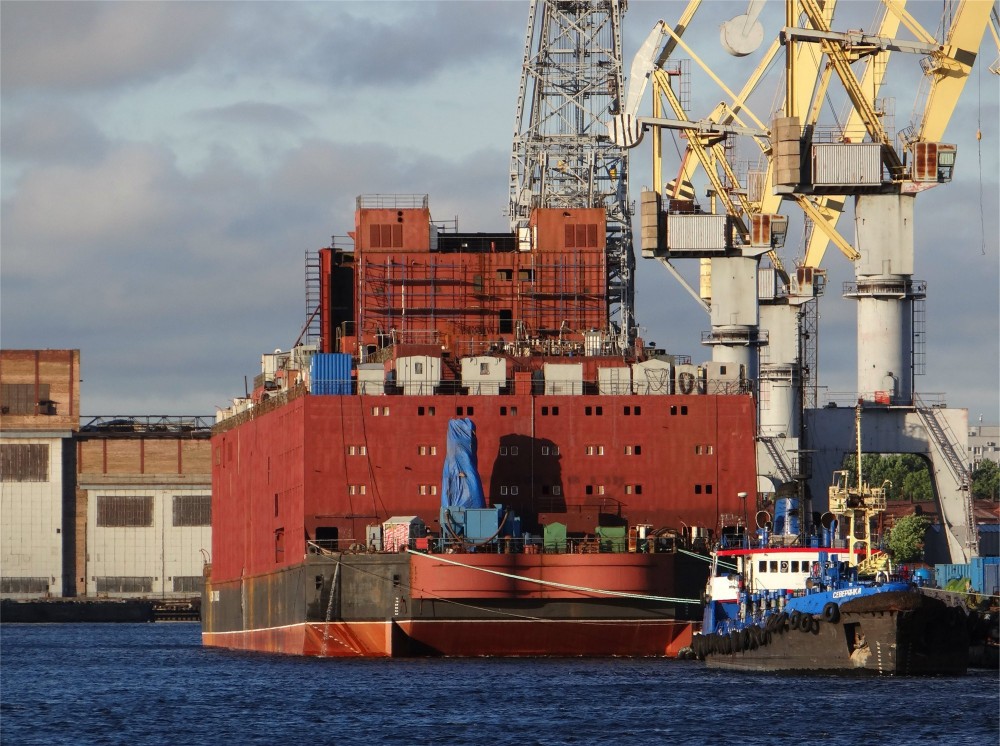
The system built to manage Russia’s nuclear legacy is crumbling, our new report shows
Our op-ed originally appeared in The Moscow Times. For more than three decades, Russia has been burdened with the remains of the Soviet ...
News

Publish date: February 28, 2018
News
A recent tour of Russia’s first floating nuclear power plant, which is under construction in St. Petersburg, included many things, but none of them could be called a tour, at least in the understanding of Alexander Nikitin, one of Bellona’s experts on the Russian nuclear industry, who ended up not getting a tour of the Akademik Lomonosov last week.
When Nikitin and 20 other experts, who represent a group of stakeholders invited for a briefing on the plant’s progress, showed up last Thursday to have a look at the plant, it turned out that the Akademik Lomonosov was just out of reach, while technicians at the Baltic Shipyard conducted tests on how much the barge and its two nuclear reactors tilt from side to side on the water, an operation called heeling.
The Akademik Lomonosov, the only floating nuclear plant under construction in the world, has been controversial since its inception in 2006. Aside from the dangers that would arise if the vessel sank or capsized, the intention to use it in a far flung region of Russia’s far east could make it juicy bait for terrorists trolling for nuclear materials.
 The Akademik Lomonosov under construction at the Baltic Shipyard. (Photo: Rosatom)
The Akademik Lomonosov under construction at the Baltic Shipyard. (Photo: Rosatom)
In that, the canceled tour – during which the barge was floated a few teasing meters from its dock at the Baltic Shipyard – was true to the form we have come to expect from Russia’s nuclear monopoly Rosatom when the subject of the floating plant comes up.
Nevertheless, Alexei Kadilov, the director of the Baltic Shipyard, let slip the key to a few mysteries surrounding the Akademik Lomonosov’s progress when he grudgingly met with Nikitin and the rest of the stakeholders’ group, thus providing at least some of the activities they were promised on their invitations.
 The Akademik Lomonosov puts in for further construction at the Baltic Shipyard. (Photo: Baltiisky Zavod).
The Akademik Lomonosov puts in for further construction at the Baltic Shipyard. (Photo: Baltiisky Zavod).
That plan changed in August after the foreign ministry of Norway appealed to Rosatom chief Alexei Likhahev, asking him not to tow two 35 watt KLT-40S nuclear reactors loaded with nuclear fuel along the country’s 6,000 kilometer coastline via the Arctic on its way to Russia’s Far East.
Likhachev assented, and said the plant would instead be fueled at Russia’s nuclear icebreaker port in Murmansk, which is along the route the Akademik Lomonosov will be towed on its way to the port of Pevek in Chukotka, where it will be moored to supply electricity
But until last week it remained almost intentionally unclear as to whether the plant’s fuel would be shipped along with the plant – which would have violated the spirit of Rosatom’s agreement with Norway – or whether it would be sent separately by train.
 Bellona's Alexander Nikitin
Credit: Bellona
Bellona's Alexander Nikitin
Credit: Bellona
He added that the Akademik Lomonosov was 95 percent complete, although a competing figure of 98.5 percent complete has been touted in Russia’s state controlled media without attribution.
But there were a number of other puzzles about the floating nuclear power plant that neither Kadilov, nor representatives of Rosenergoatom, Russia’s nuclear utility could answer.
One of these is why Pevek, a town of only 5,000 people in a far flung icebound corner of Russia’s northeast, needs an entire nuclear power plant to produce its electricity when there are hundreds of more cost effective means of doing this. That is literally a $530 million question – the current cost of the floating plant, which is four times as expensive as anyone thought it would cost – that no one Nikitin asked has an answer for.
The money lost, however is likely to mount by the time the nuclear barge arrives in Pevek. Despite vast expenditures, little in the way of creating the necessary infrastructure to pump its electricity into the town.
But that’s before the plant is even switched on. After that the electricity it produces will cost five to seven times as much as electricity produced by a typical thermoelectric plant. And while Nikitin has heard nuclear officials embrace the idea of building small capacity nuclear power plants for use in the Arctic, most acknowledge there isn’t any real reason for them to be waterborne.
So it’s not clear why Rosatom is following through with building the Akademik Lomonosov, beyond questions of simply finishing a job beset by lawsuits and property disputes and worker angst begun more than 12 years ago.
But perhaps Rosatom’s best answer to that is summed up in its plans for the further floating plants it once advertised it would build and sell throughout the world: It doesn’t have any.

Our op-ed originally appeared in The Moscow Times. For more than three decades, Russia has been burdened with the remains of the Soviet ...

The United Nation’s COP30 global climate negotiations in Belém, Brazil ended this weekend with a watered-down resolution that failed to halt deforest...

For more than a week now — beginning September 23 — the Zaporizhzhia Nuclear Power Plant (ZNPP) has remained disconnected from Ukraine’s national pow...

Bellona has taken part in preparing the The World Nuclear Industry Status Report 2025 and will participate in the report’s global launch in Rome on September 22nd.